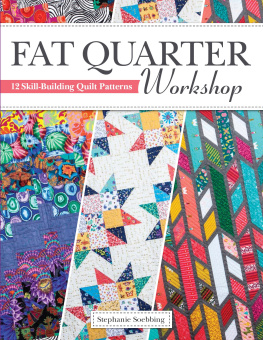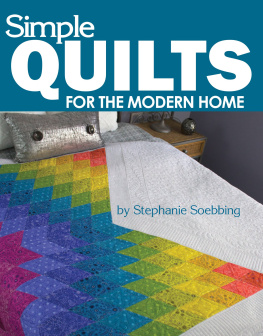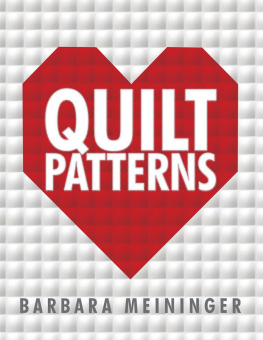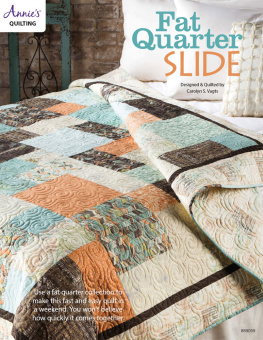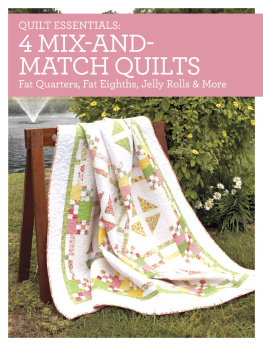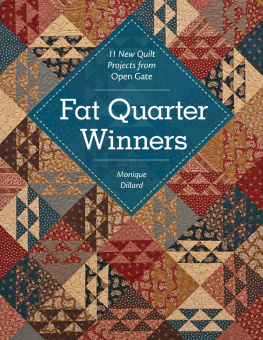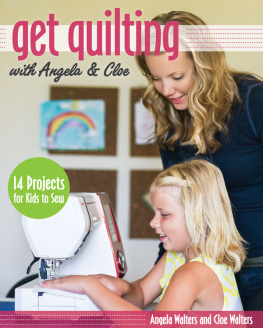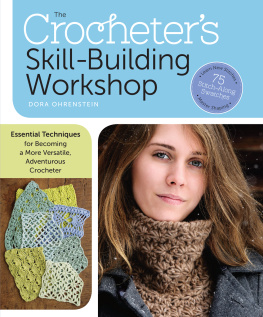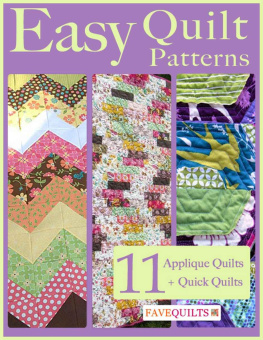Toc
Guide


Fat Quarter Workshop
Landauer Publishing (www.landauerpub.com) is an imprint of Fox Chapel Publishing Company, Inc.
Copyright 2020 by Stephanie Soebbing and Fox Chapel Publishing Company, Inc. 903 Square Street, Mount Joy, PA 17552.
Project Team
Editor: Katie Ocasio
Copy Editor: Stephanie White
Designer: Wendy Reynolds
Photographers: Mike Mihalo Photography (, and cover);
Sue Voetlin (pages [fabric], and all other photos not otherwise accredited)
Print ISBN: 978-1-947163-41-6
eISBN: 9781607658306
All rights reserved. No part of this book may be reproduced, stored in a retrieval system, or transmitted in any form or by any means, electronic, mechanical, photocopying, recording, or otherwise, without the prior written permission of Fox Chapel Publishing, except for the inclusion of brief quotations in an acknowledged review and the enlargement of the template patterns in this book for personal use only. The patterns themselves, however, are not to be duplicated for resale or distribution under any circumstances. Any such copying is a violation of copyright law.
The Cataloging-in-Publication Data is on file with the Library of Congress.
We are always looking for talented authors.
To submit an idea, please send a brief inquiry to .
Contents
Introduction
T here is a really good meme circulating online that says buying fabric and doing something with it are two different hobbies. For me, my love of fabric pre-dated my love of quilting. So, when I discovered fat quarters as a new quilter, I was instantly hooked and started collecting them.
At first, I collected by color or theme until I felt like I had enough to make a quilt. Eventually I graduated to buying fat quarter bundles when I found a line of fabric I loved but didnt have a set plan for just yet. I knew the fabric would eventually tell me what it wanted to be when it grew up.
A fat quarter is a quarter yard of fabric cut to 18" x 21" (45.72 x 53.34cm) instead of 9" (22.86cm) x WOF (width of fabric, which is about 42" [106.7cm]). The wider, shorter cut makes it very versatile to use in quilt patterns because you can cut a large variety of shapes from it. Also, by using little bits of a lot of fabrics, it is easy to create a scrappy look without needing to have a massive stash of fabric.
Now that I own my own quilt shop, one of my favorite I cant believe this is my job tasks is selecting a fabric line for our monthly Stashin with Stephanie subscription club. Each month we ship out twelve fat quarters from a new, modern quilt fabric line, and I design a new fat quarterfriendly pattern inspired by the fabric for members to make.
Many of the patterns in this book started as Stashin with Stephanie patterns and all feature fabrics from one fabric line, but also look great scrappy. Some contain zero neutral fabrics, while others give the eye a place to rest with ample background fabric. All are fast and easy to make, and you can watch video tutorials to help you make each pattern for free on our website, www.QuiltAddictsAnonymous.com/tutorials.
I hope this book inspires you to raid your stash to create color combinations that will look fabulous in these designs, tear into that fat quarter bundle that has been tied up on your shelf for years, or grab a new one from a designer you just love.
My one bit of advice is to splurge on one background fabric rather than going scrappy. Negative space is important. By sticking with one background fabric, you give the eye a place to rest which lets your favorite fabric and the design shine.
Happy Quilting,
Stephanie Soebbing
Video Tutorials
Visit my website
(www.QuiltAddictsAnonymous.com/tutorials) to see a video tutorial for each of the quilts in this book.

Principles of Modern Design
T here is no one way to define modern quilting. What is modern to one quilter may feel traditional to another. Still, there are a few design elements that are consistent across many modern quilt designs: alternative grid, expansive negative space, embracing minimalism, and modernizing traditional blocks.
For me, discovering modern quilting fabrics and designs was a way to practice the craft I loved, while creating quilts I would want in my home.
Alternative Grid
Simply put, an alternative grid breaks the traditional grid structure of quilt, which generally uses a specific number of blocks sewn together in rows. An alternative grid can be achieved by changing the focus from the center of the quilt to a corner or side of the quilt. By shifting the focus from the traditional center, the quilt becomes more modern in design and appearance.
You also could do away with the block structure all together, as in Frequency (). This quilt is still connected in rows but there is no block. The visual interest is created by fabric choice and placement rather than a complicated block design.

Frequency () is a great example of eliminating the traditional block structure so the visual interest shifts to the fabric choice and placement.
Expansive Negative Space
Many modern quilts make use of large areas of negative space. I made use of this technique in Twinkle (). This helps emphasize the parts of the quilt that are meant to shine through intricate piecing, design or fabric selection, and provides a fabulous canvas for quilting.

The negative space in Twinkle () is used as an effective way to show off the quilts piecing.
Embracing Minimalism
Despite being very colorful, Garden Plot () is an example of a minimalist quilt. The bold modern fabrics really makes it pop. Color selection, fabric choice, and simple piecing all contribute to the minimal look of a quilt.

The simple rectangular shapes and bold fabrics in Garden Plot () are what make this quilt look modern.
Modernizing Traditional Blocks
Playing around with traditional quilt blocks is a really fun way to modernize the look of your quilt. In Maze (), I updated the traditional log cabin block by playing with the block arrangement and design. Think about your favorite quilt block and how you can give it a makeover so it will belong in todays trendiest home.

Maze () uses the very traditional log cabin block in a visually interesting way that guides the eye along a specific path, from the center outward.


